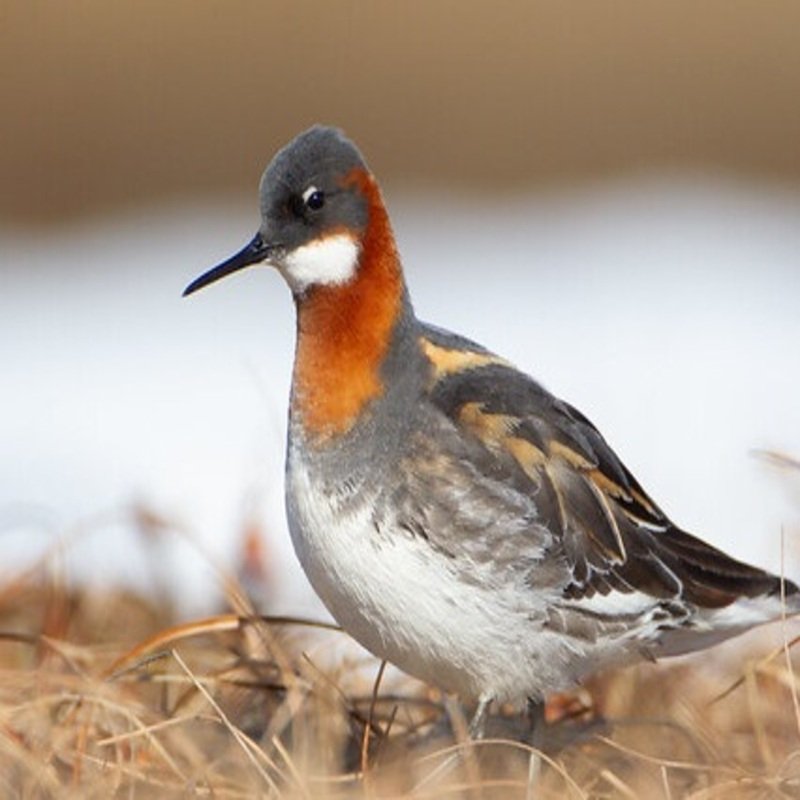The red-necked phalarope (Phalaropus lobatus), also called the northern or hyperborean phalarope, is a tiny wader. This phalarope breeds in North America and Eurasia’s Arctic regions. It is migratory and, unlike most waders, spends the winter at sea on tropical oceans.
Quick Overview: Phalaropus Lobatus – Red-Necked Phalarope
Body size: Around 7.5-8 in (19-20 cm) and a weight of 48 g (1.69 oz)
Main colors: Black, Gray, Brown, White, Red
Range: Throughout the United States
Migratory Bird: Yes
Best time of the year to see in the U.S.: March, April, May, September, October, November
Conservation Status: Least Concern
Red-necked Phalarope Description
Its bill is big and pointed, and its legs are lengthy and black with lobed toes. The female has a gray breast during the breeding season. Her back is dark gray with brown streaks. She is dark gray in color with a white area above her eyes, a dark red neck, and a white chin.

Size
These birds have a length of 7.5-8 in (19-20 cm) and a weight of 48 g (1.69 oz). Their wings could range from 14-15 in (36-38 cm).
Feeding
During the breeding season in freshwater habitats, the red-necked phalarope feeds on aquatic insect larvae (mainly mosquitoes), as well as dipteran flies, beetles, caddisflies, ants, annelid worms, and snails.
Habitat
During the nesting season, red-necked phalaropes congregate in tundra/forest-tundra habitats adjacent to lakes or wetlands with marshy riparian zones dense with grasses, moss, and sedges.
Behavior
On its summer breeding grounds, the red-necked phalarope is normally solitary unless habitat is restricted, at which point it becomes loosely colonial. These birds are extremely gregarious during migration to and from breeding sites, as well as throughout the winter when phalaropes congregate in enormous flocks.
Phalaropus Lobatus Scientific Classification
- Kingdom: Animalia
- Phylum: Chordata
- Subphylum: Chelicerata
- Class: Aves
- Order: Charadriiformes
- Family: Scolopacidae
- Genus: Phalaropus
- Species: Phalaropus lobatus
Best time of the year to see
In the United States, the best time of year to see these birds are during the Spring season (March-May) and during the Autumn season (September – November).
Distribution of the Red-necked Phalarope in the USA
The red-necked phalarope is the genus Phalaropus’s most prolific and widespread species. It is circumpolar in distribution and is found between 60 and 70 degrees latitude in both boreal and tundra zones. These phalaropes are located along the Arctic Ocean’s coasts, south to the Aleutians and northwest to the United Kingdom. The red-necked phalarope spends most of its time on the water throughout the winter. Phalaropes can be found off the coasts of central-western South America, the Arabian Sea, and central Indonesia to western Melanesia during this non-breeding season.
The Red-necked Phalarope can be found in the following states in the United States – Alabama, Alaska, Arizona, Arkansas, California, Colorado, Connecticut, Delaware, Florida, Georgia, Hawaii, Idaho, Illinois, Indiana, Iowa, Kansas, Kentucky, Louisiana, Maine, Maryland, Massachusetts, Michigan, Minnesota, Mississippi, Missouri, Montana, Nebraska, Nevada, New Hampshire, New Jersey, New Mexico, New York, North Carolina, North Dakota, Ohio, Oklahoma, Oregon, Pennsylvania, Rhode Island, South Carolina, South Dakota, Tennessee, Texas, Utah, Vermont, Virginia, Washington, West Virginia, Wisconsin, and Wyoming.
